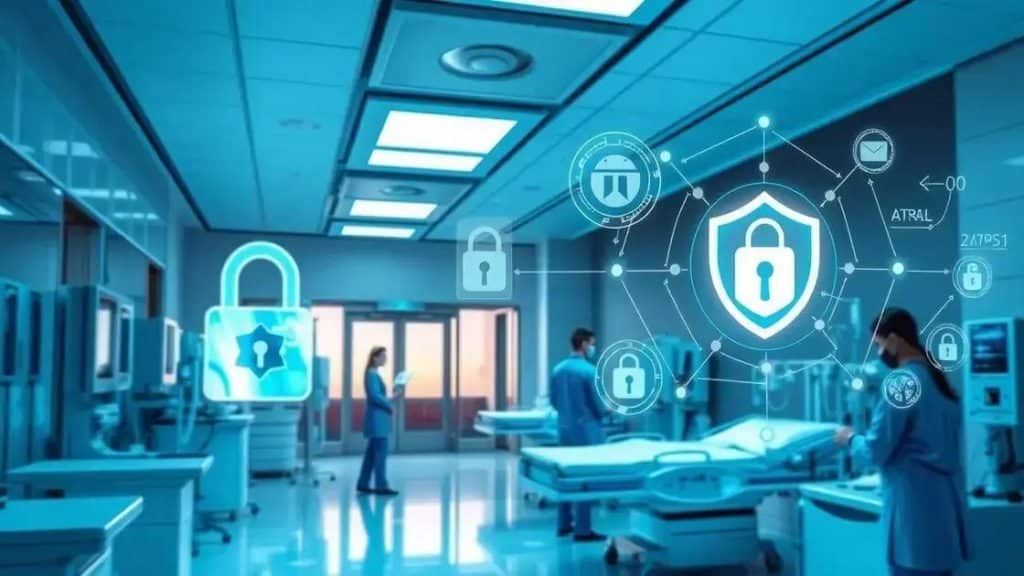Cybersecurity threats targeting healthcare sector: are you prepared?

Anúncios
Cybersecurity threats targeting the healthcare sector include phishing attacks, ransomware, and data breaches, making robust security measures and staff training essential for protecting patient information.
Cybersecurity threats targeting healthcare sector are more prevalent than ever, impacting not just institutions but also patients’ personal data. Have you considered how these threats could disrupt healthcare services? Let’s dive into the specifics of these risks and how to safeguard against them.
Anúncios
Understanding the landscape of cybersecurity threats
Understanding the landscape of cybersecurity threats is crucial for anyone involved in the healthcare sector. As the digital world evolves, so do the methods that cybercriminals use to exploit vulnerabilities.
Common Types of Cybersecurity Threats
Among the most concerning threats are:
Anúncios
- Ransomware attacks: Hackers lock essential data and demand payment for its release.
- Phishing scams: Fraudulent emails trick staff into sharing sensitive information.
- Data breaches: Unauthorized access leads to exposure of patient information.
- Insider threats: Former or current employees may misuse access to data.
Additionally, as we become more reliant on technology, the complexity of these threats increases. Each year, new vulnerabilities are discovered. For instance, systems that weren’t previously targeted may now be at risk due to outdated software or weak security protocols.
Consequences of Cyber Attacks
The implications of these cybersecurity threats can be severe. They can lead to financial losses, legal consequences, and most importantly, the compromise of patient safety. When health records are breached, it poses a significant risk to privacy.
Moreover, hospitals might face operational challenges. Interruptions in service from a cyber attack could delay patient care and reduce trust among stakeholders. Hence, addressing these threats is a priority.
Investing in robust cybersecurity measures is not just a recommendation; it is a necessity. By implementing effective training programs for staff and utilizing advanced security technologies, healthcare organizations can better defend against these evolving threats.
Common attack vectors in healthcare

Common attack vectors in healthcare represent pathways through which cybercriminals can exploit vulnerabilities in health systems. Understanding these vectors is essential for safeguarding sensitive information.
Phishing Attacks
Phishing attacks are one of the most prevalent threats. These attacks often come through emails that appear legitimate. A healthcare worker might receive an email prompting them to click on a link or download an attachment, unknowingly giving access to malicious software.
- Always verify the sender’s email address.
- Look for misspellings or unusual phrases.
- Avoid clicking on unknown links.
Malware and Ransomware
Another significant vector includes malware, especially ransomware, which encrypts critical data. After a successful attack, a healthcare organization may face demands for payment to regain access to their files.
Such attacks can disrupt operations and delay patient care. To mitigate these risks, it’s crucial for healthcare providers to implement robust security measures, like regular software updates and backups.
Additionally, denial-of-service attacks can target healthcare systems, overwhelming servers and making them impossible to access. These attacks can incapacitate healthcare services, which poses serious risks to patient safety.
Understanding these attack vectors allows healthcare organizations to develop better defenses. Regular training for staff on identifying threats can greatly enhance security. Investing in advanced cybersecurity technology is also necessary to detect and prevent these threats before they cause damage.
Best practices for healthcare cybersecurity
Best practices for healthcare cybersecurity are essential for protecting sensitive patient information and ensuring the integrity of healthcare services. By implementing effective strategies, healthcare organizations can reduce their risk of cyber attacks.
Regular Training and Awareness
One of the top recommendations is providing regular training for all employees. This training should focus on recognizing phishing emails, safe internet practices, and data protection rules.
- Encourage staff to report suspicious emails.
- Set up simulated phishing campaigns to test awareness.
- Provide updates on new threats and security measures.
Robust Security Measures
Investing in advanced security solutions is another critical practice. Firewalls, antivirus software, and intrusion detection systems help guard against attacks. It’s also vital to regularly update these systems to protect against the latest threats.
Furthermore, using strong passwords and enabling two-factor authentication can significantly enhance security. Ensuring that all devices and systems have up-to-date software not only protects data but also keeps the healthcare facility compliant with regulations.
Another vital aspect is securing access to sensitive information. Only authorized personnel should have access to personal health information (PHI). Implementing strict access controls decreases the risks of insider threats and breaches.
It’s also important to conduct regular security audits. Evaluating your systems and protocols helps identify vulnerabilities and areas needing improvement. Regular testing and assessments enable organizations to adapt to changing threats in real time.
The future of cybersecurity in the healthcare sector

The future of cybersecurity in the healthcare sector is rapidly evolving. As technology advances, so do the strategies used by cybercriminals. Therefore, healthcare organizations must stay ahead of these threats.
Emerging Technologies
One major trend is the adoption of artificial intelligence (AI) and machine learning. These technologies can analyze large amounts of data quickly, identifying patterns to predict and prevent cyber attacks before they happen.
- AI tools can enhance threat detection and response.
- Machine learning can adapt to new threats, improving overall security.
- Automation assists in efficiently handling repetitive tasks associated with cybersecurity.
Integration of IoT Devices
Another critical aspect is the growing reliance on Internet of Things (IoT) devices in healthcare. While these devices improve patient care and monitoring, they also introduce new vulnerabilities.
Healthcare facilities need to implement strict security measures for IoT devices. This includes setting up firewalls specifically for these devices and ensuring they receive regular updates. Furthermore, training staff to understand these new technologies and their potential risks is vital.
Collaboration between healthcare organizations and cybersecurity experts will be increasingly important. Sharing information about threats and best practices can strengthen defenses across the sector. Partnerships will help create a unified approach to security, allowing for better resource usage and faster response times.
Finally, regulations and compliance will likely become stricter as more data breaches occur. Organizations will need to focus more on ensuring compliance with laws and regulations to protect patient information. This compliance should not be viewed merely as a requirement but as a crucial part of maintaining trust with patients.
FAQ – Frequently Asked Questions about Cybersecurity in Healthcare
What is the importance of cybersecurity in healthcare?
Cybersecurity is vital in healthcare to protect sensitive patient information from breaches and cyber attacks, ensuring patient safety and trust.
How can healthcare organizations train their staff on cybersecurity?
Organizations can conduct regular training sessions focusing on recognizing threats, safe internet practices, and data protection policies.
What are common cybersecurity threats in healthcare?
Common threats include phishing attacks, ransomware, data breaches, and insider threats that can compromise patient data and services.
What technologies can help improve cybersecurity in healthcare?
Emerging technologies like artificial intelligence and machine learning can enhance threat detection and response, making systems more secure.





